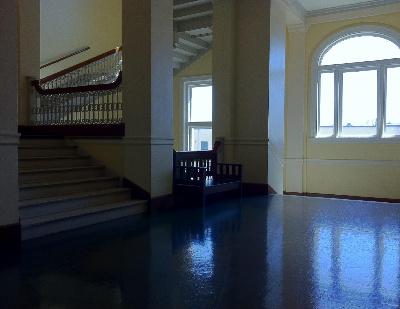I turn on the radio in the car (where I usually listen to hiphop music) and hear a recording of Haydn’s F-Minor Variations. I don’t change the station. Within seconds, I’m thinking about the bright, separate envelope of every treble note in the recording. Lovely, but not really legato. Must be a German Steinway, I think.
Whatever else pianists may be doing, in order to play piano music — piano keys move vertically, down and then up again in order to begin and end sounds.
 In singing, or playing wind instruments, musicians exhale and inhale. Violinists draw the bow through space. These ways of producing tone seem more linear than piano playing. Playing a keyboard is inherently “digital.” The piano’s a big box with levers. Can the physical gestures of sound production ever be dissociated from musical intention, or rhythm?
In singing, or playing wind instruments, musicians exhale and inhale. Violinists draw the bow through space. These ways of producing tone seem more linear than piano playing. Playing a keyboard is inherently “digital.” The piano’s a big box with levers. Can the physical gestures of sound production ever be dissociated from musical intention, or rhythm?
In the car, with the Haydn recording playing, I’m wondering how much the verticality of piano playing always impedes musical line. I saw Alfred Brendel, at Carnegie Hall, playing final resolution chords of delicate cadences with clear downward motion of the wrist — contrary to my approach. That can’t work, I’d think. And, as I listened, I’d try to separate the visual impression from the sonic result. Mr. Brendel made the wrong gesture (?), it seemed to me, but by listening very attentively he managed the sound.
In the car, at the end of the recording, a voice identifies the player: “Alfred Brendel, pianist.” I won’t say I guessed the peformer’s identity; my recollections while listening were responses to a “signature.” In this case, Mr. Brendel’s particular signature of envelope management, the way he begins and ends tone.
I’ve suggested before, that every musician has a “rhythm signature” — manifested, for example, in the way two eighth-notes are made in place of a quarter-note. My eighth-notes are 51% as long as my quarter-notes, while yours may be 48%!
In this recording of Haydn’s music, Mr. Brendel attends to individual piano tones with earnest care. He lets us hear his hearing of a moment in time. He allows us to hear an era — with this millennial jeu perlé.
The sound of music moves through space and time. (And music may signify motion through space and time.) In order to play music, musicians usually have to move through space in time.
Within our conscious perception, how do we balance attention to details (in the small) and awareness of larger coherence? We may speak with clear enunciation, fine pronunciation of every word — but what are we saying?
Does more perfect note-accuracy lead to less linear connection? Close-up modern recording reveals details of surface unheard from Row M in Carnegie Hall. Our particular relationship to balancing awareness of close surface attention and big-picture coherence belongs to this moment, to our time, now.

What hip-hop artists do you like?
I’m not a connoisseur. Some of what I’ve heard recently: Trey Songz, J Cole, Common, Jay-Z, Jeremih, Tyga, KanYe, Drake, Lil Wayne, and of course, B.o.B.